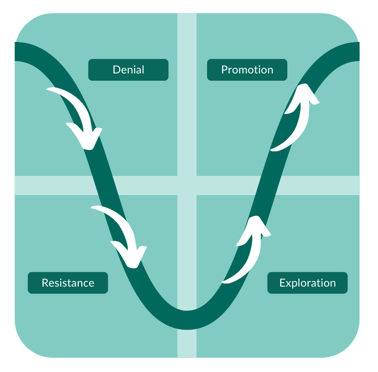Personal Change & Strategy Deployment
It has been well documented that many business projects and strategies never reach their full potential for a whole myriad of reasons; in my personal experience, successful deployments always include gaining the support of the people.
A catch cry coming from many a board room is “I do not understand how everyone cannot see the benefit in this new program?”, they still blunder forward, losing good people along the journey.
At Industry Partners Australia (IPA), we have just released our 2022 to 2025 business strategy, with some significant changes. As CEO, I know our people will fit into four categories in our personal change model:
- Denial – Those people that do not see the need for change as we may already be market leader, so why upset the apple cart.
- Resistance – Those that do not like some or all the changes for various reasons.
- Exploration – Those that are happy to take a closer look and come along for the ride.
- Promotion – Those who tell everyone this is excellent for the business and individuals (usually the CEO or project leader).

Why does it matter where people are in the change curve?
We hear “the only constant is change” and “change is critical for business growth”, both are correct.
People in ‘Denial’ will quickly change to the next phase in the curve, moving through to ‘Resistance’ once they understand that the changes are inevitable.
The critical factor is how long they stay in ‘Resistance’ before moving on to ‘Exploration’.
People in the ‘Promotion’ phase of change would rather ignore those in ‘Denial’ than deal with those in ‘Resistance’, so many leaders ignore them.
People in ‘Resistance’ come in many forms, from the protagonist who takes every opportunity to let people know when something does not work as expected to the quiet, backstabbing politician who undermines from a safe distance.
The ‘Resistance’ phase is critical, as too many people in ‘Resistance’ make it very difficult to implement a successful change.
How can you help those in ‘Resistance’?
- Explain the vision and respect the past.
- Understanding concerns in an open team environment will move some people into ‘Exploration’ by simply listening.
- Respond to those concerns and allay any personal fears.
- Provide data supporting your business strategy.
- Show them examples of the future.
- Support those that move into ‘Exploration’.
Some will sadly not move from ‘Resistance’, no matter how much energy and teamwork are spent on them, but it is critical for the rest of the people to see you have tried.
The key to success is to have most people at least in ‘Exploration’ with a small handful in ‘Promotion’.
To learn more about the IPA personal change model, please contact your local Operations Manager.
Gary Silversides | CEO
.png?width=190&name=IPA%20Logo%20Transparent%20(Hi-Res).png)





